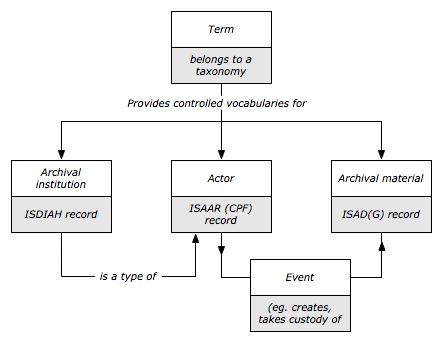Difference between revisions of "Editing UM-1.3/es"
Jump to navigation
Jump to search
| Line 3: | Line 3: | ||
[[Main Page]] > [[User manual|(UM) User manual]] > [[UM-1 | UM-1 System overview]] > UM-1.3 Tipos de entidades | [[Main Page]] > [[User manual|(UM) User manual]] > [[UM-1 | UM-1 System overview]] > UM-1.3 Tipos de entidades | ||
| − | Una [[Entity|entidad]] es un objeto sobre el que almacena datos un sistema de información. La arquitectura del ICA-AtoM's incluye un número importante de tipos de [[Entity| | + | Una [[Entity|entidad]] es un objeto sobre el que almacena datos un sistema de información. La arquitectura del ICA-AtoM's incluye un número importante de tipos de [[Entity|entidad]], pero desde el punto de vista del usuario final hay cuatro tipos principales que son con los que interactuará: |
*[[Archival description|Descripción Archivística]] | *[[Archival description|Descripción Archivística]] | ||
| Line 16: | Line 16: | ||
[[Image:um1-3Entities2.png|442px|right|thumb|Core entities and their relationships]] | [[Image:um1-3Entities2.png|442px|right|thumb|Core entities and their relationships]] | ||
| − | ''' | + | '''Descripción Archivística''' |
| − | * | + | *Proporciona información contextual sobre los materiales de archivo. |
| − | * | + | *Está organizada en niveles jerárquicos ([[Fonds|fondos]], series, expedientes, documentos). |
| − | * | + | *Incluye [[Data element|campos]] basados en los estándares internacionales de descri`pción archivística RS-1 e ISAD-G's ''General International Standard Archival Description'' ([[RS-1|ISAD-G]]). |
Latest revision as of 08:20, 22 January 2009
Please note that ICA-AtoM is no longer actively supported by Artefactual Systems.
Visit https://www.accesstomemory.org for information about AtoM, the currently supported version.
Tipos de entidades
Main Page > (UM) User manual > UM-1 System overview > UM-1.3 Tipos de entidades
Una entidad es un objeto sobre el que almacena datos un sistema de información. La arquitectura del ICA-AtoM's incluye un número importante de tipos de entidad, pero desde el punto de vista del usuario final hay cuatro tipos principales que son con los que interactuará:
Descripción Archivística
- Proporciona información contextual sobre los materiales de archivo.
- Está organizada en niveles jerárquicos (fondos, series, expedientes, documentos).
- Incluye campos basados en los estándares internacionales de descri`pción archivística RS-1 e ISAD-G's General International Standard Archival Description (ISAD-G).
Authority records (actors)
- Provide descriptions of the actors (corporate bodies, persons and families) that interact with archival materials as creators, custodians, subject access points, etc.
- Include data elements based on the ICA's International Standard Archival Authority Records (Corporate bodies, Persons, Families) (ISAAR(CPF)).
- Are linked to archival descriptions in ICA-AtoM by events delimited by start / end dates. Through events, 1 actor can have 0, 1 or many relationships to 0, 1 or many archival units; and 1 archival unit can have 0, 1 or many relationships to 0, 1 or many actors. Event relationships link ISAAR authority files (descriptions of actors) and ISAD records (descriptions of archival materials).
Archival institutions
- Provide descriptions of repositories that preserve and provide access to archival materials.
- Include data elements based on the ICA's International Standard for Describing Institutions with Archival Holdings (ISDIAH).
- Are actors that hold archival materials. Like all actors, an archival institution has its own ISAAR authority record. But its characteristics as a repository (e.g. its opening hours, research services, contact information) are described separately in an ISDIAH institution record. The ISDIAH elements that are inherited from its ISAAR authority record are: Authorized form of name, Other forms of name, Parallel forms of name, History, Mandates/Sources of Authority, and Administrative structure.
Terms
- Provide controlled vocabularies used throughout the system (e.g. as access points or in drop-down value lists).
- Are organized into separate taxonomies.
- Include minimal data elements; a future iteration of ICA-AtoM will extend one such taxonomy ("Function description") to include the elements found in the ICA's International Standard For Describing Functions (ISDF).
